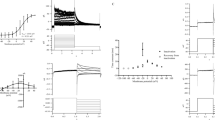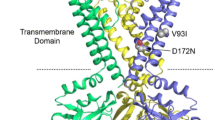Abstract
Gain of function in mutations, D172N and E299V, of Kir2.1 will induce type III short QT syndrome. In our previous work, we had identified that a mixture of traditional Chinese medicine, styrax, is a blocker of Kir2.1. Here, we determined a monomer, hydrocinnamic acid (HA), as the effective component from 18 compounds of styrax. Our data show that HA can inhibit the currents of Kir2.1 channel in both excised inside-out and whole-cell patch with the IC50 of 5.21 ± 1.02 and 10.08 ± 0.46 mM, respectively. The time course of HA blockage and washout are 2.3 ± 0.6 and 10.5 ± 2.6 s in the excised inside-out patch. Moreover, HA can also abolish the currents of D172N and E299V with the IC50 of 6.66 ± 0.57 and 5.81 ± 1.10 mM for D172N and E299V, respectively. Molecular docking results determine that HA binds with Kir2.1 at K182, K185, and K188, which are phosphatidylinositol 4,5-bisphosphate (PIP2) binding residues. Our results indicate that HA competes with PIP2 to bind with Kir2.1 and inhibits the currents.







Similar content being viewed by others
References
Bavro VN, De Zorzi R, Schmidt MR, Muniz JR, Zubcevic L, Sansom MS, Venien-Bryan C, Tucker SJ (2012) Structure of a KirBac potassium channel with an open bundle crossing indicates a mechanism of channel gating. Nat Struct Mol Biol 19:158–163
Beacham DW, Blackmer T, O’Grady M, Hanson GT (2010) Cell-based potassium ion channel screening using the FluxOR assay. J Biomol Screen 15:441–446
Biasini M, Bienert S, Waterhouse A, Arnold K, Studer G, Schmidt T, Kiefer F, Cassarino TG, Bertoni M, Bordoli L, Schwede T (2014) SWISS-MODEL: modelling protein tertiary and quaternary structure using evolutionary information. Nucleic Acids Res 42:W252–W258
Casini S, Postma AV (2012) Decreased inward rectification of Kir2.1 channels is a novel mechanism underlying the short QT syndrome. Cardiovasc Res 93:535–536
Chang HK, Shieh RC (2013) Voltage-dependent inhibition of outward Kir2.1 currents by extracellular spermine. Biochim Biophys Acta 1828:765–775
D’Avanzo N, Lee SJ, Cheng WW, Nichols CG (2013) Energetics and location of phosphoinositide binding in human Kir2.1 channels. J Biol Chem 288:16726–16737
Deo M, Ruan Y, Pandit SV, Shah K, Berenfeld O, Blaufox A, Cerrone M, Noujaim SF, Denegri M, Jalife J, Priori SG (2013) KCNJ2 mutation in short QT syndrome 3 results in atrial fibrillation and ventricular proarrhythmia. Proc Natl Acad Sci USA 110:4291–4296
Fakler B, Brandle U, Glowatzki E, Weidemann S, Zenner HP, Ruppersberg JP (1995) Strong voltage-dependent inward rectification of inward rectifier K+ channels is caused by intracellular spermine. Cell 80:149–154
Ficker E, Taglialatela M, Wible BA, Henley CM, Brown AM (1994) Spermine and spermidine as gating molecules for inward rectifier K+ channels. Science 266:1068–1072
Gaita F, Giustetto C, Bianchi F, Schimpf R, Haissaguerre M, Calo L, Brugada R, Antzelevitch C, Borggrefe M, Wolpert C (2004) Short QT syndrome: pharmacological treatment. J Am Coll Cardiol 43:1494–1499
Hansen SB, Tao X, MacKinnon R (2011) Structural basis of PIP2 activation of the classical inward rectifier K+ channel Kir2.2. Nature 477:495–498
Hattori T, Makiyama T, Akao M, Ehara E, Ohno S, Iguchi M, Nishio Y, Sasaki K, Itoh H, Yokode M, Kita T, Horie M, Kimura T (2012) A novel gain-of-function KCNJ2 mutation associated with short-QT syndrome impairs inward rectification of Kir2.1 currents. Cardiovasc Res 93:666–673
Katz B (1949) Les constantes electriques de la membrane du muscle. Arch Sci Physiol 3:285–299
Kubo Y, Baldwin TJ, Jan YN, Jan LY (1993) Primary structure and functional expression of a mouse inward rectifier potassium channel. Nature 362:127–133
Kurachi Y (1985) Voltage-dependent activation of the inward-rectifier potassium channel in the ventricular cell membrane of guinea-pig heart. J Physiol 366:365–385
Kurata HT, Akrouh A, Li JB, Marton LJ, Nichols CG (2013) Scanning the topography of polyamine blocker binding in an inwardly rectifying potassium channel. J Biol Chem 288:6591–6601
Lopes CM, Zhang H, Rohacs T, ** T, Yang J, Logothetis DE (2002) Alterations in conserved Kir channel–PIP2 interactions underlie channelopathies. Neuron 34:933–944
Lu Z, MacKinnon R (1994) Electrostatic tuning of Mg2+ affinity in an inward-rectifier K+ channel. Nature 371:243–246
Mazzanti A, Kanthan A, Monteforte N, Memmi M, Bloise R, Novelli V, Miceli C, O’Rourke S, Borio G, Zienciuk-Krajka A, Curcio A, Surducan AE, Colombo M, Napolitano C, Priori SG (2014) Novel insight into the natural history of short QT syndrome. J Am Coll Cardiol 63:1300–1308
Morris GM, Goodsell DS, Halliday RS, Huey R, Hart WE, Belew RK, Olson AJ (1998) Automated docking using a Lamarckian genetic algorithm and an empirical binding free energy function. J Comput Chem 19:1639–1663
Patel C, Antzelevitch C (2008) Pharmacological approach to the treatment of long and short QT syndromes. Pharmacol Ther 118:138–151
Pegan S, Arrabit C, Zhou W, Kwiatkowski W, Collins A, Slesinger PA, Choe S (2005) Cytoplasmic domain structures of Kir2.1 and Kir3.1 show sites for modulating gating and rectification. Nat Neurosci 8:279–287
Phillips JC, Braun R, Wang W, Gumbart J, Tajkhorshid E, Villa E, Chipot C, Skeel RD, Kale L, Schulten K (2005) Scalable molecular dynamics with NAMD. J Comput Chem 26:1781–1802
Priori SG, Pandit SV, Rivolta I, Berenfeld O, Ronchetti E, Dhamoon A, Napolitano C, Anumonwo J, di Barletta MR, Gudapakkam S, Bosi G, Stramba-Badiale M, Jalife J (2005) A novel form of short QT syndrome (SQT3) is caused by a mutation in the KCNJ2 gene. Circ Res 96:800–807
Ren S, Pang C, Li J, Huang Y, Zhang S, Zhan Y, An H (2017) Styrax blocks inward and outward current of Kir2.1 channel. Channels (Austin) 11:46–54
Shi C, Zhu W, Yao F (2009) A study on chemical constituents for the essential oil of Liquidambar orientalis Mill. J Shandong Educ Inst 133:79–83
Su D, Yao F, Shi Z (2005) SFE CO2 and analysis of chemical components in Liquidambar orientalis Mill. West China J Pharm Sci 20:409–411
Wang HR, Wu M, Yu H, Long S, Stevens A, Engers DW, Sackin H, Daniels JS, Dawson ES, Hopkins CR, Lindsley CW, Li M, McManus OB (2011) Selective inhibition of the K(ir)2 family of inward rectifier potassium channels by a small molecule probe: the discovery, SAR, and pharmacological characterization of ML133. ACS Chem Biol 6:845–856
Wang S, Peng Y, **a H, Zhou Y, Wang J, Zeng N (2012) GC–MS of volatile chemical constituents of Liquidambar orientalis. China Pharm 23:1393–1394
**e LH, John SA, Ribalet B, Weiss JN (2008) Phosphatidylinositol-4,5-bisphosphate (PIP2) regulation of strong inward rectifier Kir2.1 channels: multilevel positive cooperativity. J Physiol 586:1833–1848
Zhang H, He C, Yan X, Mirshahi T, Logothetis DE (1999) Activation of inwardly rectifying K+ channels by distinct PtdIns(4, 5)P2 interactions. Nat Cell Biol 1:183–188
Acknowledgements
This work was supported by the Natural Science Found for Distinguished Young Scholars of the Hebei Province of China (Grant Nos. C2015202340 to HA, C2013202244 to YC), the Foundation for Outstanding Talents of Hebei Province of China (Grant No. C201400305 to HA), and the National Natural Science Foundation of China (Grant Nos. 11247010 to HA, 11175055 and 11475053 to YZ, 11347017 to SZ, 31400711 to YC, 31600594 to CP). We thank **g Du coming from School of Foreign Languages of Hebei University of Technology with the help of English usage.
Author information
Authors and Affiliations
Corresponding authors
Ethics declarations
Conflict of interest
The authors declare that they have no conflict of interest.
Ethical approval
This article does not contain any studies with human participants or animals performed by any of the authors.
Rights and permissions
About this article
Cite this article
Ren, S., Pang, C., Huang, Y. et al. Hydrocinnamic Acid Inhibits the Currents of WT and SQT3 Syndrome-Related Mutants of Kir2.1 Channel. J Membrane Biol 250, 425–432 (2017). https://doi.org/10.1007/s00232-017-9964-z
Received:
Accepted:
Published:
Issue Date:
DOI: https://doi.org/10.1007/s00232-017-9964-z




